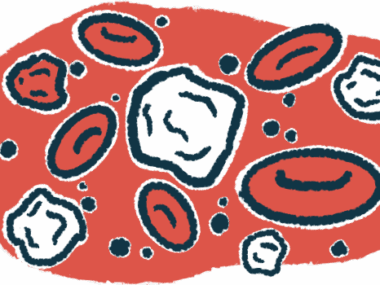B-cell Sugar Metabolism Overly Active in Sjögren’s; May Be Treatment Target
The glucose pathway glycolysis is essential for B-cell activation, proliferation in the disease
Written by |

Sugar metabolism — all chemical reactions involved in making or breaking down glucose, or blood sugar — is overly active in B-cells, a type of immune cell implicated in Sjögren’s syndrome, and may provide a target for developing treatments, a study suggests.
The study, “mTORC1-GLUT1-mediated glucose metabolism drives hyperactivation of B cells in primary Sjögren’s syndrome,” was published in Immunology by a team of researchers in China.
Sjögren’s occurs when the body’s immune system wrongly launches an attack against cells in the body. Because this is usually directed against cells of the glands that make saliva and tears, the main symptoms of Sjögren’s are dry mouth and dry eyes.
Cells need glucose for energy and overactive B-cells may need much more of it. To get the energy they need, cells can use either one or both of two glucose pathways. These signaling cascades are called glycolysis and oxidative phosphorylation.
Glycolysis allows cells to make energy even when there is no oxygen, but the amount of energy it yields is low. Oxidative phosphorylation requires the presence of oxygen, but provides cells with much more energy compared with glycolysis.
Do overactive B-cells pick a pathway?
Which of the two pathways is most used by overactive B-cells in Sjögren’s is not known. To know more, researchers collected B-cells from the blood of patients with primary Sjögren’s and compared their use of glucose with that of B-cells from healthy people.
The study included 36 women with primary Sjögren’s who had never taken medications or had stopped taking medications at least six months before it started. They had a mean age of 46.1 and had the disease for a median of 12 years. The study also included 38 healthy women with a mean age of 45.9 who served as controls.
B-cells were put in a lab dish and given some stimuli to grow. Both B-cells from patients and controls powered up glycolysis and started consuming more oxygen. But patients’ B-cells had greater glycolytic capacity than the controls’ B-cells, meaning they were able to break down a higher number of glucose molecules to make energy. They also were able to consume more oxygen when needed for oxidative phosphorylation.
To be able to use glucose as a source of energy, cells first need to take it in. They do this by shuttling glucose transporters to their outer membranes. Researchers saw that B-cells from patients had up to four times as much GLUT1, one of these glucose transporters, as control B-cells. The gene coding for GLUT3, another glucose transporter, was also more active in patients’ B-cells.
While it was clear B-cells could use both glycolysis and oxidative phosphorylation, researchers wanted to know which of these pathways was key for them to become active. To test this, they exposed B-cells to 2-DG, a molecule that differs from glucose in one particular site only, which is enough to prevent it from being broken down during glycolysis. Without glycolysis, both B-cells from patients and healthy people stopped proliferating.
Researchers then treated B-cells with metformin, a medication to treat diabetes that blocks a step in the oxidative phosphorylation pathway. Metformin stopped B-cells from patients — but not control B-cells — from proliferating. Only 2-DG decreased amounts of CD80 and CD86, two markers of B-cell activation, in B-cells from patients.
“These results indicated that glycolysis was essential for [B-cell] activation and proliferation in [primary Sjögren’s] patients,” the researchers wrote.
To zero in on the step of glycolysis that may be key for B-cell activation, researchers treated B-cells with rapamycin, a molecule that inhibits the mTORC1 protein. This protein is not just essential for immune cell activation, but also instructs cells to grant entry to glucose. Rapamycin blocked B-cell proliferation and activation and also prevented them from turning into plasma cells, which are specialized B-cells that can make antibodies.
“These results suggested that mTORC1-dependent glycolysis is an essential metabolic pathway involved in the hyperactivation of [B-cells] in [primary Sjögren’s] patients,” the researchers wrote.
Both 2-DG and metformin blocked the ability of activated B-cells to turn into plasma cells. They both also decreased the amount of antibodies made and released by patient B-cells.
While oxidative phosphorylation may also be key for B-cells, results suggest that “targeting glycolysis might be a potential therapeutic strategy for [primary Sjögren’s] patients,” the research team wrote.






